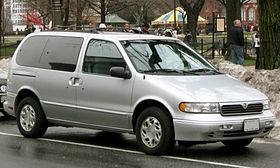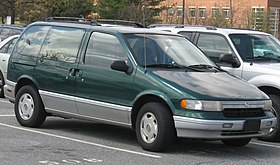Mercury Villager
| Mercury Villager | |
|---|---|
 |
|
| Overview | |
| Manufacturer | Mercury (Ford) |
| Also called | Nissan Quest |
| Production | 1992–2002 |
| Assembly | United States: Avon Lake, Ohio |
| Body and chassis | |
| Class | Minivan |
| Layout | FF layout |
| Platform | Ford VX54 platform |
| Powertrain | |
| Transmission | 4-speed automatic |
| Dimensions | |
| Wheelbase | 112.2 in (2,850 mm) |
| Chronology | |
| Successor | Mercury Monterey |
| First generation | |
|---|---|
 |
|
| Overview | |
| Also called |
Nissan Quest Yunbao YB6480 (China) Dongfeng EQ6482 (China) |
| Production | 1992–1998 |
| Assembly |
Avon Lake, Ohio, U.S. Guangzhou, China |
| Body and chassis | |
| Body style | 3-door minivan |
| Powertrain | |
| Engine | 3.0 L 151 hp (113 kW) VG30E V6 |
| Dimensions | |
| Length | 189.9 in (4,823 mm) (1993–95) 190.2 in (4,831 mm) (1995–98) |
| Width | 73.7 in (1,872 mm) (1993–95) 73.8 in (1,875 mm) (1995–98) |
| Height | 67.6 in (1,717 mm) (1993–95) 67.5 in (1,714 mm) (1995–98 GS Cargo) 65.9 in (1,674 mm) (1995–98 GS) 65.6 in (1,666 mm) (1995-98 Nautica & LS) |
| Curb weight | 3,815 lb (1,730 kg) |
| Second generation | |
|---|---|
 |
|
| Overview | |
| Production | 1998–2002 |
| Designer | Moray Callum (1995) |
| Body and chassis | |
| Body style | 4-door minivan |
| Powertrain | |
| Engine | 3.3L 180 hp (134 kW) VG33E V6 SOHC |
| Dimensions | |
| Length | 194.7 in (1999–2000) 194.9 in (2001–02) |
| Width | 74.9 in (1,902 mm) |
| Height | 70.1 in (1,781 mm) |
| Curb weight | 3,944 lb (1,789 kg) |
The Mercury Villager is a minivan manufactured by Nissan and marketed by Ford's Mercury subdivision for the model years 1993–2002, across a single generation. Internally designated as model VX54, the Villager was a rebadged variant of the Nissan Quest—a product of a joint venture between Ford and Nissan, manufactured at Ford's Ohio Assembly plant in Avon Lake, Ohio.
Noted for its innovative seating configurations, the Villager featured a folding, removable, middle seat (or two buckets) along with a non-removable, fold-and-slide track-mounted rear seat. The arrangement enabled the rear seat to slide forward to the middle position for five-passenger seating, or completely forward against the front seats for a larger cargo volume.
"Villager" first appeared at Ford as the name of the Edsel station wagon, the Edsel Villager, in 1958. The Villager name resurfaced at Mercury on a woodgrained Comet station wagon from 1962 to 1967, and subsequently on similarly trimmed wagons in other Mercury series, including the Montego (1970–1976), Bobcat (1975–1980), Cougar (1977 and 1982), Zephyr (1978–1981) and Lynx (1981–1984). On Mercuries, the Villager name almost always denotes a top trim, wood grained wagon. Villager was the equal of the Ford designation "Squire". The Mercury equivalent of the more well known Country Squire full-size station wagon was the Colony Park.
In 1987, Ford and Nissan entered a joint agreement to develop an all-new vehicle to compete in the minivan segment scheduled for 1991. Ford's version of the vehicle, however, was to be a Mercury rather than a Ford due to the simultaneous development of the Ford Windstar. Development officially began later that year under the codename VX54, with the final designs being chosen in 1989. Prototypes went into initial testing in 1990 at Ford and Nissan test tracks, later real-world testing throughout 1991, with development concluding at the end of that year. The first-generation Villager was introduced in 1992 as a 1993 model.
...
Wikipedia
